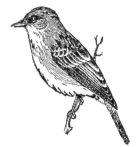PEWEB 1463
Description
This page of the book is from "The New Student's Reference Work: Volume 3" by Chandler B. Beach, Frank Morton McMurry and others.
PEWEB
1463
PHÆOPHYCEÆ
able petroleum-wells the porous layer containing the petroleum is usually covered by a relatively impervious layer, which prevents the oil from escaping upward. When well-boring penetrates this impervious layer, the oil has a chance to escape. It sometimes spouts with great force, like water in flowing wells. In other cases it has to be pumped. A well which flows when first made, often ceases to flow later and its oil has to be pumped. Still later it may cease altogether to yield oil, because the reservoir (the porous rock) from which it drew its supply, is exhausted. The average length of life of an oil-well is but a few years. The yield is very variable, some yielding but a few barrels a day, while others yield hundreds or even thousands a day. Such extraordinary flows are usually of short duration.
Petroleum is found in various parts of the world, the United States and Russia being the chief sources of supply. In the United States petroleum-wells were first developed in Pennsylvania, Ohio and West Virginia, but now extensive deposits have been opened in many other states, including Indiana, Illinois, Kentucky, Texas, Kansas, Oklahoma. Colorado and California. In 1908 the total production in the United States was 179,572,479 barrels (of 42 gallons), a total of 7,541,044,018 gallons.
Petroleum occurs in formations of various ages. That of western Ohio, Indiana, Michigan and Canada occurs in rocks of the Ordovician system; that of Tennessee and Kentucky in the Silurian; that of New York and Pennsylvania in the Devonian; that of West Virginia and eastern Ohio in the Lower Carboniferous; that of Kansas in the Carboniferous; and that of Texas and the western states in the Cretaceous and Tertiary formations. Petroleum, as derived from wells, is crude, and is subjected to refining processes before it is put on the
TTlarlCGt
See Órton: Geology of Ohio, Vol. VII; U. S. Geological Survey, 8th Annual Report, Part I ; and Bulletin of the Geological Society of America, Vol. I.
Pe'wee or Wood=Pewee, a small flycatcher sometimes confused with the phcebe. It is smaller than the latter, being about six and one half inches long, a trifle larger than the English sparrow. Its wings are decidedly longer than its tail; it is dark olive-green above, below whitish tinged with yellow ; the under bill is yellow. Unlike the
phcebe, it is shy rather than sociable, uttering its plaintive cry, even in the hottest days of mid-summer. It is a forest bird, one of the few birds fond of deep shade, is much at home high in tree-tops, common in old orchards where insects abound, and is occasionally seen in garden and roadside trees. It ranges in eastern North America from Florida to Canada, and is one of our common summer residents. It arrives from the south toward the middle of May and returns south in October, wintering in Central America. During the nesting season it seeks deep seclusion and on a limb 20 or 40 feet above ground builds its nest, a rival to the humming-bird's in beauty. The nest is flat, made of moss, fine grasses and rootlets and cleverly edged with lichen or moss so that it may seem a very part of lichen or moss-covered limb. There are three or four cream-white eggs with lilac spots at the larger end. It has a dreamy note of pee-a-wee.
Phædra (fē-arä), the wife of Theseus, is the central figure of a tragic story in Greek mythology, which was made the subject of dramas by Euripides and Sophocles. These dramas are now lost; but there is a tragedy upon the theme by Racine. Phædra fell in love with the youthful Hippolytus, a son of Theseus and Hippolyte. The youth repelled her advances, whereupon she made a false accusation against him to Theseus, who in his wrath put Hippolytus to death. The queen, repenting of her crime, confessed all, and took her life with her own hand.
Phædrus (Je'drus), translator of Æsop's (a. v.) Fables from Greek into Latin verse. While still young he came to Italy, and in Rome or some other city studied Ennius, whom he quotes in the epilogue to his third book. From the title of this book he appears to have been first the slave and afterwards the freedman of Augustus Although Phædrus only claimed to be a translator of Æsop, he was more; he wrote fables of his own, using the name of Æsop to recommend his verses. Phædrus lived in the early part of the first Christian century.
Phæophyceæ (Jē'Ô-fïs'e-e), plants forming one of the great groups of algæ, commonly known as the brown algæ or kelps. Almost all are marine, and are characteristic forms of the coast. All are anchored forms, their floating olive-green, yellow or brown bodies usually being buoyed by floats or air-bladders. The largest kelps are in the colder waters, and are also called wrack, tangle, dangle etc. Some are filamentous forms, but others are much more complex. The species of Laminaria are like huge floating and rooted leaves, frequently nine to ten feet long. The largest known Laminaria is an antarctic form, which rises to the surface from a sloping bottom, with a floating, leaf-like body 000 to 900 feet long. Other

PEWEE


